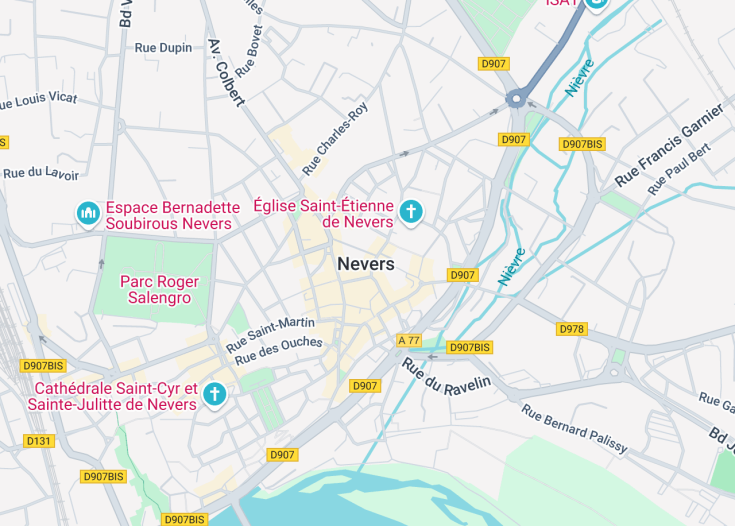Nevers, nestled on the banks of the Loire River in central France, is an enchanting city steeped in rich history and culture. Its picturesque cobblestone streets and vibrant heritage make it a captivating destination for travelers. The city is renowned for its art and history museums, including the Nevers Cathedral and the Ducal Palace, highlighting its significant role in medieval European history. Nevers also offers a unique blend of traditional pottery craftsmanship with its famous Nevers faience, making it a key cultural hub in the Burgundy region.
When visiting Nevers, ensure to explore the Saint-Cyr-et-Sainte-Julitte Cathedral, an architectural masterpiece with exquisite stained glass windows and a serene ambiance.
Consider timing your visit to coincide with the Festival de Nevers, a vibrant celebration of music and arts that showcases both classical and contemporary performances.
Top things to do & see in Nevers
Select the following sights and activities to discover best tickets and tours available in Nevers.
Nevers: A Hidden Gem in the Heart of France
| Country | France |
| Time in Nevers | GMT+1 |
| Language spoken | French |
| Population | 34,841 (Source: Latest Census Data) |
| Currency | Euro (€, EUR) |
| Airports |
|
Nevers, a picturesque city in the Burgundy region of central France, boasts a rich history and vibrant cultural scene. Known for its religious heritage, Nevers is home to the stunning Nevers Cathedral and the Duke’s Palace, which stands as testimony to the town’s medieval past. The city is also renowned for its art and history museums, attracting tourists who are keen to explore French artistic traditions and historical artifacts.
Where is Nevers?
Located in the Burgundy region, Nevers rests near the convergence of the Loire and Nièvre rivers, offering scenic views and a tranquil environment.
Distances:
| Route | Distance by car | Time by car |
|---|---|---|
| Paris to Nevers | 240 km | 2h 40m |
| Lyon to Nevers | 200 km | 2h 15m |
| Marseilles to Nevers | 570 km | 5h 10m |
What is Nevers famous for?
Nevers is celebrated for its artistic Faience pottery, fine porcelain, and as the historical capital of the duchy. Its Ducal Palace is one of the first of the Loire castles and a major attraction.
History
Nevers, a city steeped in history, traces its origins back to prehistoric times and has evolved through various historical epochs. Here, we explore some of the most significant periods in the city’s development.
Pre-Roman and Gallo-Roman Era
Nevers began as a settlement of the Aedui, a Gallic tribe. It gained prominence following its conquest by Julius Caesar. The Roman influence is evident in the ancient remains dotted around the city, illustrating a period of prosperous development under Roman rule. It became known as Noviodunum, meaning “new fort” in Gaelic.
Medieval Period (500 AD – 1500 AD)
The Middle Ages were crucial in shaping Nevers into a religious and political center. The construction of the Saint-Cyr-et-Sainte-Julitte Cathedral, an enduring symbol of the city, began in this era. Its distinct Gothic and Renaissance styles reflect the city’s growth and architectural evolution. This period also saw Nevers becoming a ducal seat, which enhanced its political importance in France.
16th Century Renaissance
The Renaissance brought about significant cultural development in Nevers. The city became famous for its faience pottery, a craft that combined Italian majolica styles with local influences, making it a hub for artists and craftsmen. Additionally, the 16th century marked continued expansion and embellishment of architectural landmarks.
Industrial Era to Present Day (19th Century – 21st Century)
The 19th century ushered in industrialization, with Nevers expanding its economic base beyond traditional crafts to include mining and later, the railway industry. In recent decades, Nevers has focused on cultural tourism and preserving its rich historical legacy while integrating modern amenities and services for residents and visitors alike. The city continues to celebrate its historical roots while adapting to contemporary needs.
Visit Nevers
What to see and do in Nevers
Nevers is a city rich in history and culture, offering a range of activities and attractions for visitors:
- Explore the historic heart of Nevers, including the Saint-Cyr-et-Sainte-Julitte Cathedral, known for its impressive Gothic and Renaissance architecture.
- Visit the Palais Ducal, considered one of the first Loire castles built in the Renaissance style.
- Stroll along the Loire River for scenic views and serene walking paths.
- Discover the city’s renowned pottery workshops and perhaps purchase unique faience pottery as souvenirs.
Nevers encapsulates a blend of historical richness and artistic charm, making it a captivating destination.
Annual Events in Nevers
Nevers hosts several recurring events throughout the year, enriching its cultural landscape:
- Nevers à Vif: A vibrant music festival held annually in October, showcasing a mix of rock and contemporary music.
- The Nevers Film Festival: Occurring every November, it highlights new talents in French and international cinema.
These events contribute to the lively atmosphere of Nevers, drawing both locals and tourists.
Best time to visit Nevers
The best time to visit Nevers is during the spring (April to June) and fall (September to October). During these months, the weather is generally pleasant, and the city’s natural and architectural beauty is at its peak, complemented by a less crowded atmosphere.
Is Nevers worth visiting?
Nevers offers a compelling blend of historical gravitas, cultural richness, and artistic flair, making it well worth a visit. The city’s well-preserved architectural landmarks, including the Saint-Cyr-et-Sainte-Julitte Cathedral and the Palais Ducal, offer a glimpse into its illustrious past. However, those seeking bustling nightlife or extensive modern attractions might find it quieter than some larger cities. The potential language barrier could also be a challenge for non-French speakers. Nevertheless, for those interested in history, culture, and serene landscapes, Nevers is an enriching destination that meets a wide array of travel expectations.









